C-130 Factory: How Iconic Hercules Airlifters Are Born
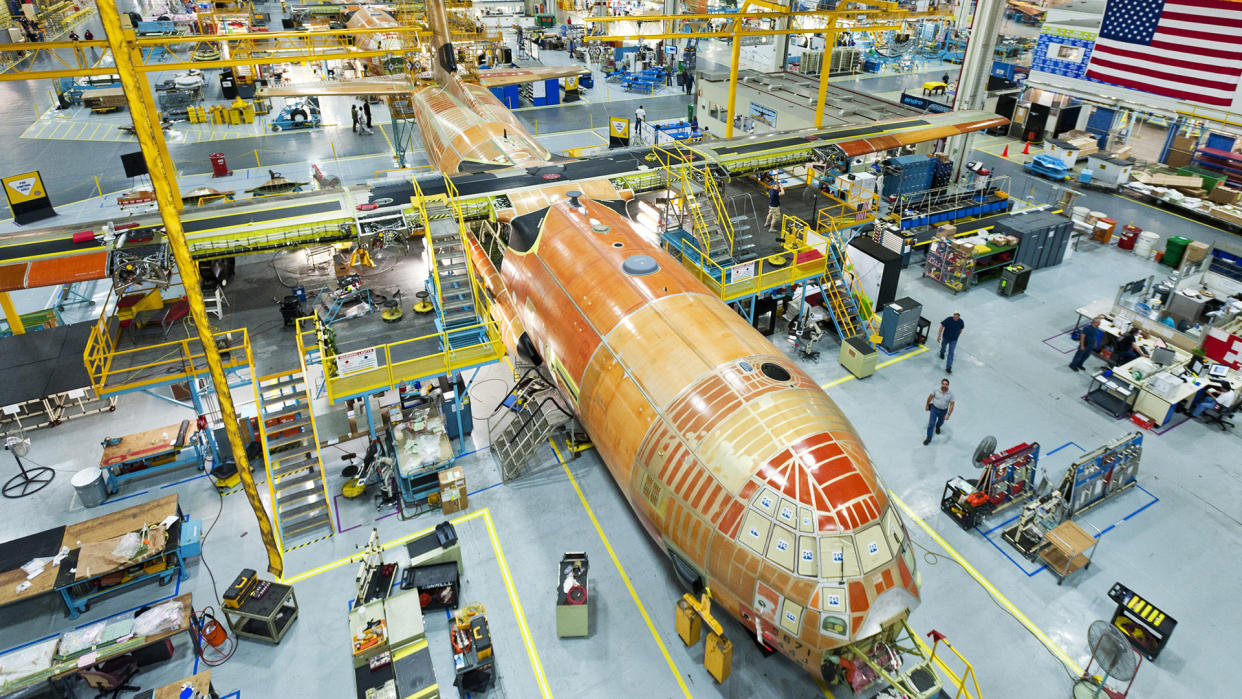
Building a large military transport aircraft from scratch is no easy feat. The complexity of conceiving, designing, manufacturing, and then bringing together over a million individual parts to create such a flying machine is challenging, to say the least. Yet turning that process into a 70-year success story is another thing entirely. Such a rare, winning formula is embodied in the Lockheed Martin C-130 Hercules.

Lockheed started building C-130s in Marietta, Georgia, in 1954, and production of the C-130J Super Hercules variant continues to this day, making the Hercules the longest-running military aircraft production line in history. With its four turboprop engines, long straight wings, and capacious fuselage, seeing the huge main sections of these airlifters coming together in the company’s vast Marietta plant is truly a sight to behold. It’s here, at the birthplace of all but two of the over 2,700 C-130s ever built, that we got a view into how each C-130 is born and how its iconic past is influencing its bright future.
Origins of the Hercules
The Hercules was designed by a team led by Willis Hawkins to meet a specification issued by the U.S. Air Force’s Tactical Air Command in 1951. The first two YC-130 prototypes were built in Burbank, California, from where the first flight was conducted on August 23, 1954. Serial production of the C-130A commenced in Marietta the same year, with the first examples entering USAF service two years later in December 1956. The pace at which this project progressed was remarkable.
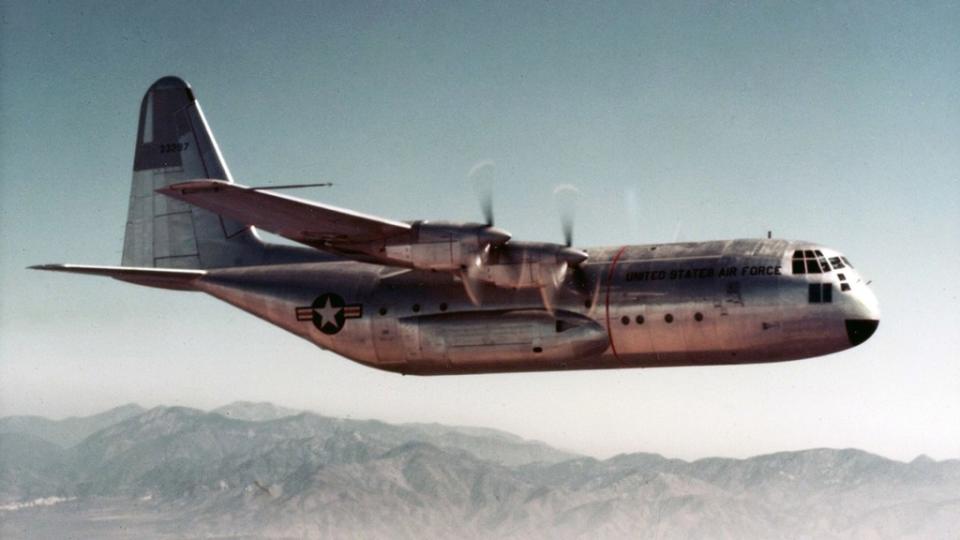
At the height of the production program, over 100 C-130s were being built in Marietta every year, with a record 140 Herks built there in 1957. Aside from the two prototypes, the 3.4 million square feet Hercules production line is the only place in the world where Hercules have been built.
Lockheed Martin’s Marietta plant in Cobb County, Georgia, is co-located with Dobbins Air Reserve Base. The facility started out as the Bell Bomber Plant, originally known as Government Aircraft Plant 6, and later changed to Air Force Plant 6, and it commenced operations under the Bell Aircraft name in April 1943 specifically to produce the B-29 Superfortress under license to Boeing. In January 1951, it became the Lockheed Aircraft Corporation’s Georgia Division, which was initially occupied refurbishing B-29s for the Korean War. The plant went on to manufacture classic Lockheed aircraft such as the C-141 StarLifter, the C-5 Galaxy, the F-22 Raptor, and of course, the C-130 Hercules.
Built during World War II, the Marietta plant was designed with the rigors of war in mind. It combined a large blacked-out production plant (that was the first in the South to be air-conditioned) with an extensive bomb shelter that enabled some employees to work almost entirely underground. A huge network of tunnels connected various departments of the site and workers could move about the plant without ever needing to venture outside.
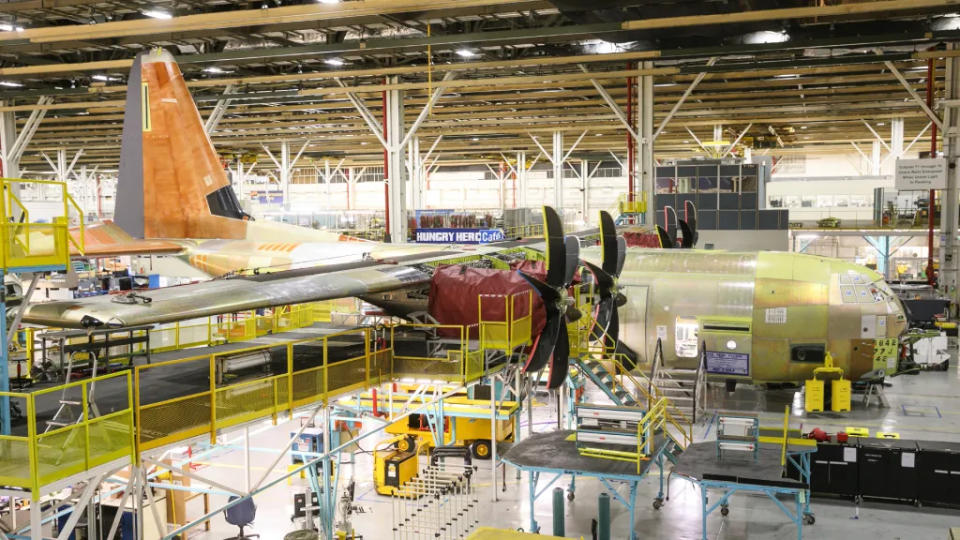
Today, the underground tunnels still exist, and some of these are still used as office and training spaces. The plant now contributes over $4.4 billion in terms of annual economic impact in Georgia, with approximately 5,700 Lockheed Martin employees working here on programs including building F-35 center wing sections, and coating F-35 horizontal and vertical stabilizers. There is also an expanding presence from Lockheed Martin’s secretive advanced development organization known as the Skunk Works®, which has spurred an increase in the employee base that is supporting “multiple classified efforts.”
70 years of building Herks
Lockheed Martin now exclusively manufactures the C-130J variant, which began production in 1994. Production of the original models of the C-130 ran from 1954 to 1997, with 2,271 “legacy” Herks built in four major variants, culminating in the C-130H. The final H-model Hercules was delivered to Japan in September 1997, as production concentrated on the new-generation C-130J Super Hercules.
Comparing the original 1954-vintage C-130A to the current C-130J reveals massive evolution, with major improvements including the four Rolls-Royce AE2100D3 engines and composite, six-bladed, GE-Dowty Aerospace R391 propellers with significantly improved fuel economy and hot-and-high performance, a glass cockpit, and advanced avionics. These features resulted in higher levels of onboard automation and a move from a four-person cockpit crew to a two-crew cockpit, with optional capacity for a flight engineer/navigator.
“As a pilot, what struck me most wasn’t just the increased performance of the C-130J, it was the situational awareness that comes with this plane,” says Bill Morrison, a C-130 production test and training pilot at Lockheed Martin. Morrison has extensive experience across the various Hercules models, having flown both the now-retired MC-130P Combat Shadow and the latest MC-130J Commando II in U.S. Air Force Special Operations Command service. “As a pilot, to have all of this information that the C-130J provides is enormously important – it’s all about situational awareness.”
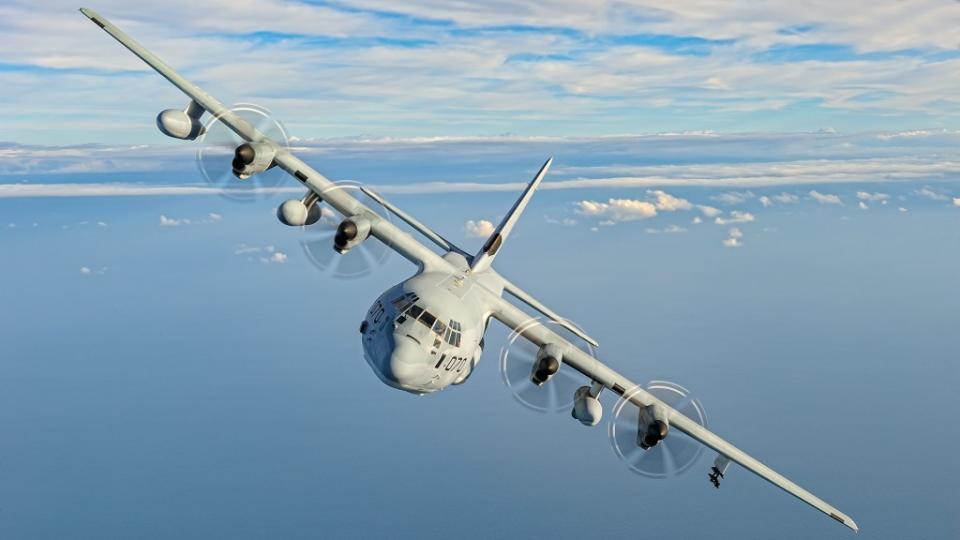
“We get a lot more thrust for every revolution of that propeller,” Morrison adds. “We feel that in our takeoff and landing performance. In the ‘legacy’ C-130 we can always operate in short-field austere environments. Now [with the J-model] we can get in and out of even more restricted fields with a big increase in payload.”
The strong, robust, airframe was a winner from the very first early model C-130s. Much is made of this inherent strength and durability of the Hercules airframe – which finds its origin in the C-130’s engineering and comes to life on the production line in Marietta.
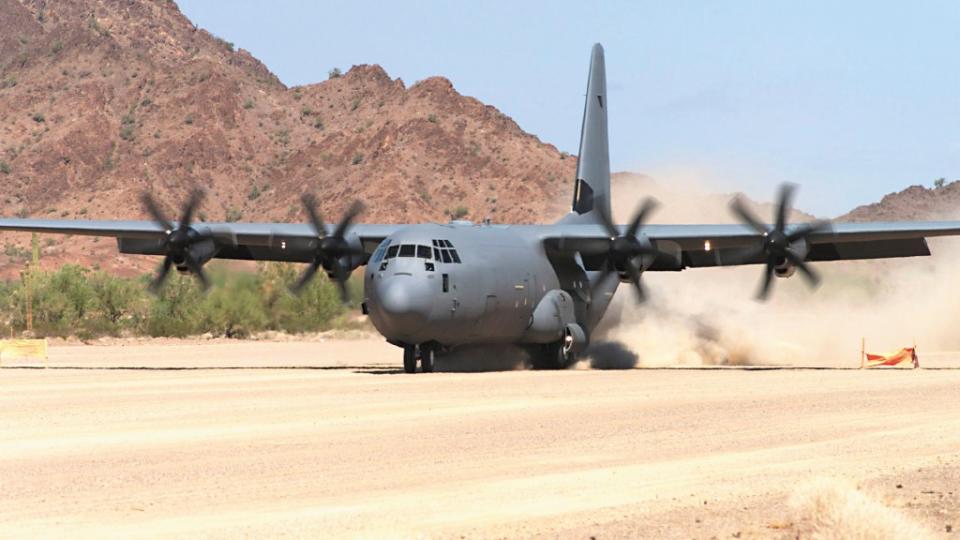
“A lot of the airframe is made from extruded aluminum, which is like using a pasta press for metal,” says Kevin Mather, director of C-130J Production Operations at Lockheed Martin. “It extrudes at a rate of a couple of inches per minute and it’s very strong. We use titanium for the engine mounts and the only composite materials [in the C-130J] are the flaps and on the fairings around the wings.”
“This isn’t like building a fighter aircraft, which is hole-to-hole assembly, with the Hercules the engineers have to clamp, tack, and drill the major subassemblies to bring them together.”
“This is a moving production line that starts with [the] manufacture of the outer wings. It’s a six-month process that incorporates things like ballistic protection for the fuel tanks. The wings are built in three main parts, including the Center Wing Box, which is where the wings are attached to the fuselage,” says Mather.
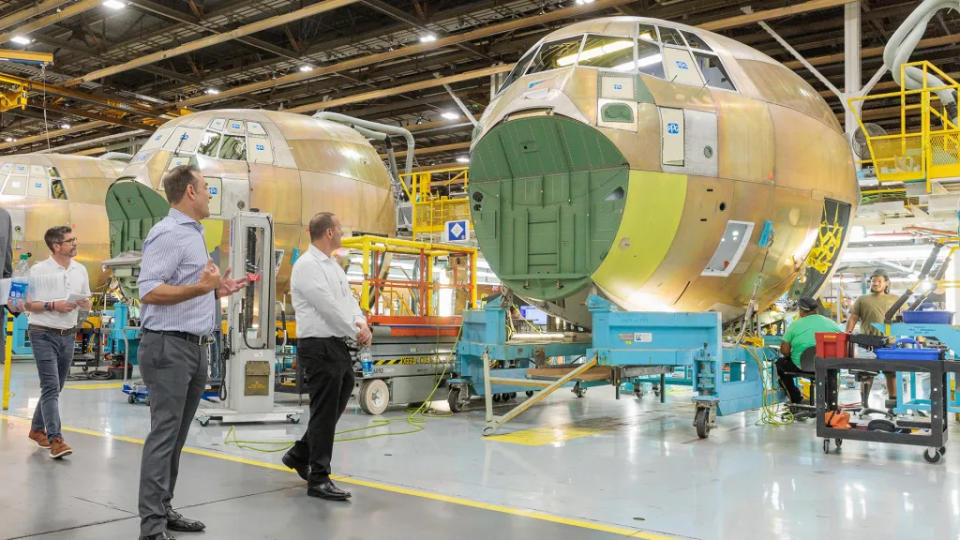
While C-130 final assembly is conducted in Marietta, many of the major components are built at other Lockheed Martin sites or by sub-contractors. The fuselage sides and floor are built at the company’s sub-assembly plant in Meridian, Mississippi. Other major components are fabricated at plants in Clarksburg in West Virginia, Johnstown in Pennsylvania, and at Pinellas Park in Florida.
Tata in India makes the horizontal and vertical stabilizers, Quikstep in Australia manufactures the wing flaps, and Greece’s Hellenic Aerospace Industries produces the fuselage plug for the stretched C-130-30 variant that features 55 feet of cargo compartment length – an additional 15 feet over the “short” aircraft.
“Separately we build the nose and cockpit section from scratch,” explains Mather. “The next major phase is to mate the nose, middle fuselage, and tail together. We also make here all of the six miles of wiring that goes into every single Hercules.” Mather says: “It takes about a year to build a Hercules, and we can have up to 36 in production at a time.”
Current market
“As we mark 70 years of Hercules production this year, that success really comes down to the C-130’s multi-mission value proposition,” says Nicholas Smythe, director of international air mobility business development at Lockheed Martin. “The Hercules covers 18-plus missions around the world, and that really allows it to meet market and operator demand.” Lockheed Martin has delivered over 540 C-130Js to date, with overall deliveries to 26 operators in 22 different countries, and the C-130J fleet has accumulated nearly three million flight hours.
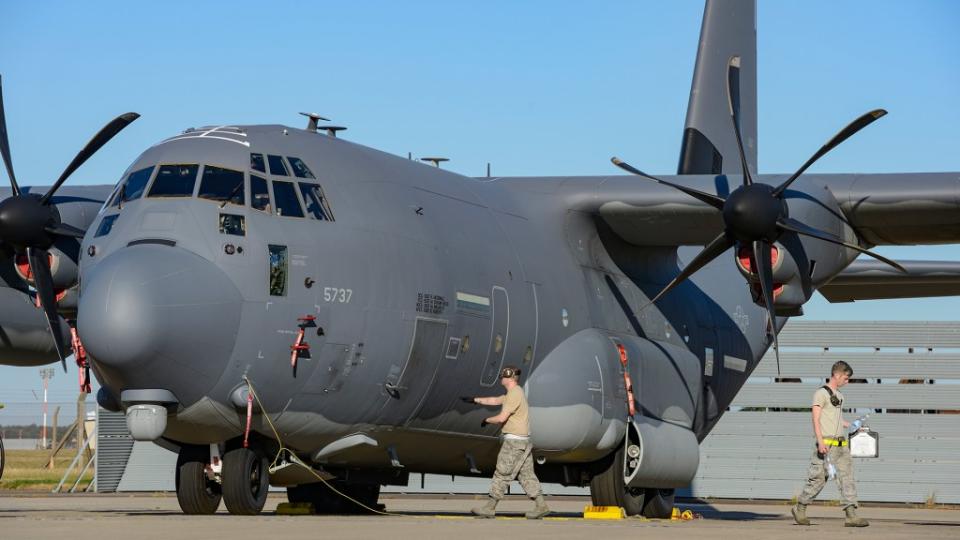
Lockheed Martin has had up to nine different versions of the Hercules in production at one time. “Right now on the line you can see a combination of C-130Js, stretched C-130J-30s, KC-130J tankers, and various special mission HC-130J and MC-130J aircraft,” says Smythe. “Being able to meet market demand from our customers in terms of the variant of aircraft that best meets their mission needs is really the secret to the resiliency and longevity of this production line.”
“In my time on the C-130 program, I’ve seen production rates at 12-per-year and I’ve seen rates as high as 36-per-year, and we’re tooled to achieve 36-per-year. As of right now in 2024 the line is at a 20 aircraft [per year] production rate, but it’s not just the production line, it’s the entire supply chain that sits behind it in our ability to work with our key suppliers across many U.S. states, and many countries around the world, that feed the global supply chain that then comes to Marietta to be assembled on this line.”
“From when a customer orders an aircraft to when they can expect to receive their aircraft is on average a 36-month delivery timespan. The flexibility we have in place to meet that operator demand as it goes up and down is very, very important. When it comes to the resiliency of this production line, it’s really about the scalability and the longevity that ensures that when we produce this aircraft, it’s not just the capability that comes across the line, but it’s meeting all of the correct price points and meeting the expectations of these different customers.”
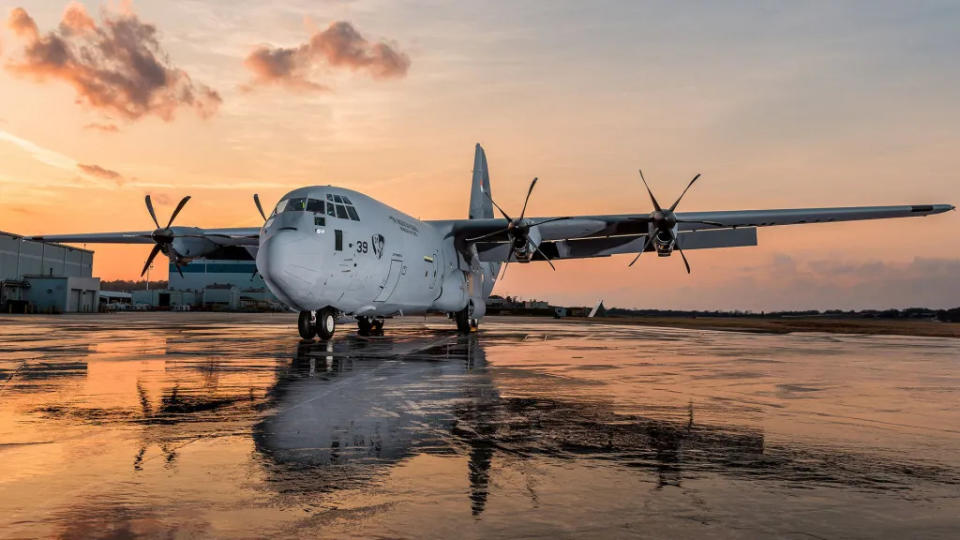
“There’s a number of aircraft for international customers [including Indonesia and New Zealand] that are on the line right now, and we have U.S. government customers that are on the line right now – that’s HC-130Js, MC-130Js, KC-130Js, C-130Js, and in the past, we’ve had our FAA-certified LM-100J on this line.”
Of the different variants that are produced, some of the various C-130 mission modifications are now incorporated on the production line such as a satellite communications antenna for the New Zealand aircraft, while some are added post-production, as is the case with the AC-130J Ghostrider gunship. This variant is based on the MC-130J airframe, and it receives mission modifications and weapons systems from Lockheed Martin Missiles and Fire Control in Crestview, Florida.
“Ultimately, it comes down to the business case in terms of when we should incorporate different mission modules. As an example, we have HC-130Js and MC-130Js being produced for U.S. Air Force Air Combat Command and Air Force Special Operations Command respectively. Those are produced off this line as highly similar aircraft that then receive post-production modifications for their particular mission variants.”
“There are also things that we’ll just do entirely on this production line. A KC-130J for the U.S. Marine Corps, for example, comes off this line ready to go into operations immediately.” The KC-130J is a tanker/transport variant of the Hercules. It features twin Cobham Series 48 AR refueling pods on the wings for the tanker mission that are installed during production at Marietta.
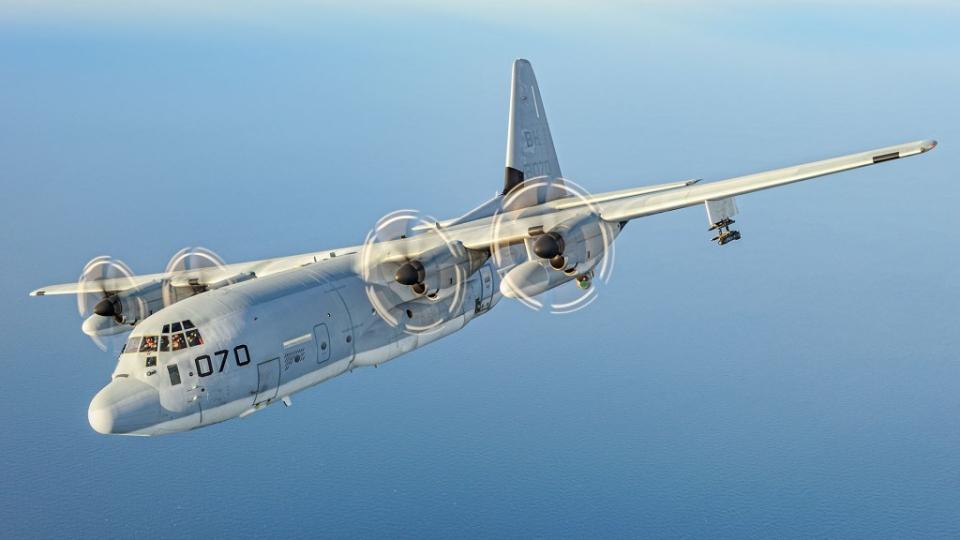
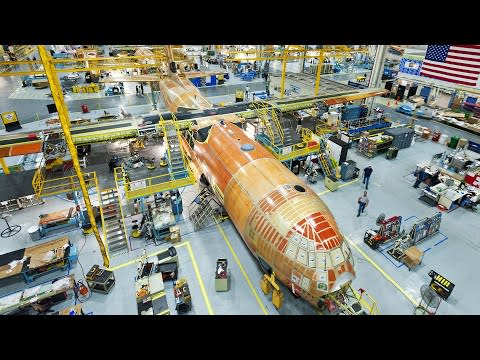
Immaculate new C-130Js are passed to the production test team at Marietta as they roll off the line. A rigorous set of ground and flight tests are mandated before the aircraft are ferried to their respective customers. “New C-130s off the production line come here to the south side of the airfield to us at flight operations,” says Bill Morrison. “For that first flight we’re basically getting airborne and making sure the plane performs and behaves the way we expect it to before we ever turn it over to the customer. If everything goes well then we can do it all in a day, but sometimes it may turn into two, maybe three flights.”
Lockheed Martin also prepares C-130 customers for operating the aircraft, and it has a large Hercules Training Center at Marietta. This is used to train aircrews and maintainers in the specifics of the C-130. “We have a full motion simulator and other training devices. We can train here or off-site,” says Morrison, noting a brand new European C-130 training center at Évreux-Fauville Air Base in northern France. The Franco-German C-130 air transport squadron has taken delivery of 10 KC/C-130J tanker and transport aircraft, which has been a major new program for Lockheed Martin, and adds a new customer for the Hercules in the shape of the Luftwaffe.
“The strongest demand we currently see internationally is for the C-130J-30, the stretched variant, which meets a lot of mission requirements in terms of the extended [fuselage] size, while still having all the great capability in the aircraft,” comments Nicolas Smythe. “We have 10-plus active campaigns around the world with customers who are looking to buy either additional C-130Js or get into the C-130J family [for the first time]. Whether it’s ski-birds for the Antarctic, or whether it’s an enhanced version of [the] C-130J built around resilient mobility and non-permissive environments. We see a growing demand for that type of configuration.”
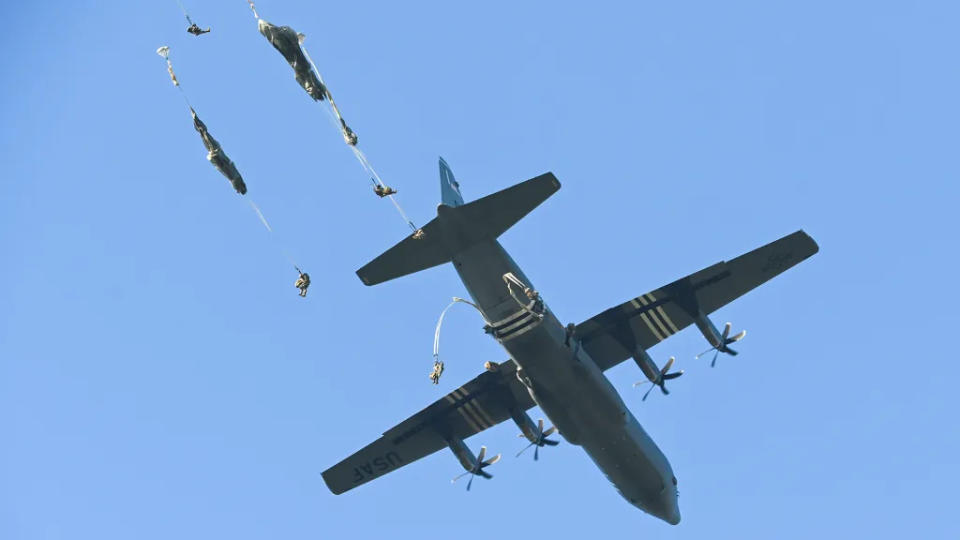
Other C-130 variants that have been touted could also attract sales, such as the Special Operations Forces (SOF) international configuration that was unveiled in 2017. The civilian LM-100J commercial freighter is the Super Hercules variant of the L-100 and it received its FAA certification in 2019. Five examples have been delivered to launch customer Pallas Aviation in Fort Worth, Texas. The LM-100J Fire Herc has also been offered since 2018 as a civil-certified air tanker.
The future path for Hercules
Lockheed Martin’s Nicholas Smythe says C-130 connectivity will be an important consideration for the type of operations the Hercules may need to face in the future. “Maybe the C-130 can be a communications node inside of Joint All Domain Operations, handling Command and Control [C2] roles. I think the interconnectedness, the overall concept of connectivity, is going to be very important to the evolving mission of the C-130J in that contested space.”
Gen. Mike Minihan, the head of Air Mobility Command, which controls many active duty C-130Js, has stressed the importance of improving connectivity between U.S. Air Force mobility air and ground crews in large, dispersed, operating areas such as the Pacific. The current reliance on line-of-sight radios will need to be enhanced with beyond line-of-sight systems that are able to relay classified information. Minihan wants to connect 25 percent of the Hercules fleet by 2025.
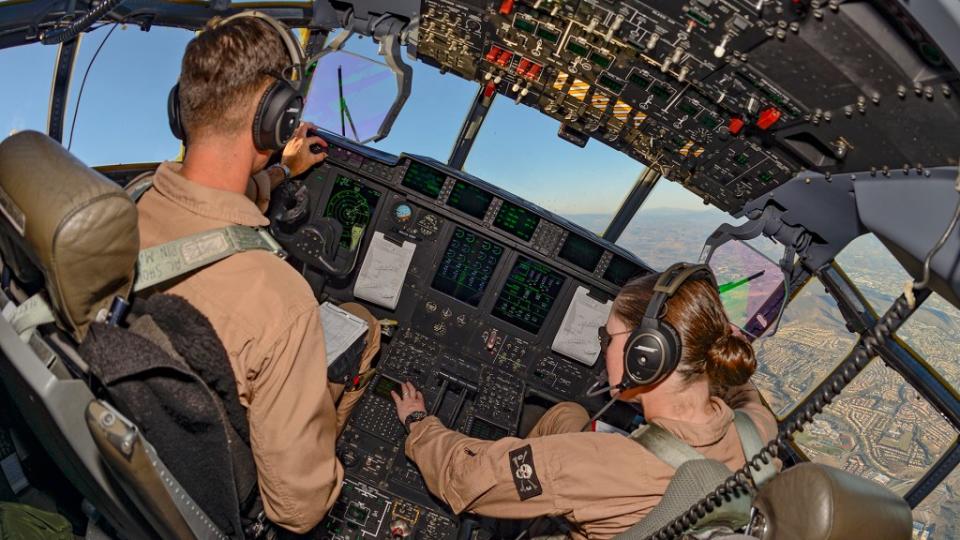
“Single pilot C-130 operation is also definitely on the table for the Hercules in the future,” says Smythe. It’s a possible evolution that The War Zone has previously examined in detail. “That’s the first step in a journey towards greater autonomy. It’s something that we’ve been studying for a while now, potentially how the co-pilot role could be achieved through some Artificial Intelligence techniques. Crew workload is going to be a determinant factor in looking at single pilot operations.”
The U.S. Air Force is looking at a variety of options and concepts for Next-Generation Airlifters to replace types such as the C-5 Galaxy, C-17 Globemaster III, and the C-130, that would be suited to operations in a high-end contested battlespace. While these new cargo-haulers of the future may ultimately replace some traditional types for contested missions, the C-130 will remain in demand for a wide variety of missions for a significant period ahead.
“We’re going to listen to those operators and we’re going to continuously modernize this product,” says Smythe. “Our intent is to be producing C-130s at least to the year 2040 at this point based upon what operators are telling us about what they need in terms of tactical transport.”
If C-130s keep rolling off the production line until that target date and potentially well beyond, the iconic Hercules will without a doubt be serving en masse well past the century mark from when the first YC-130 took to the skies over Burbank so long ago.
Contact the author: jamie.hunter@teamrecurrent.io

